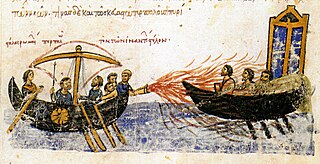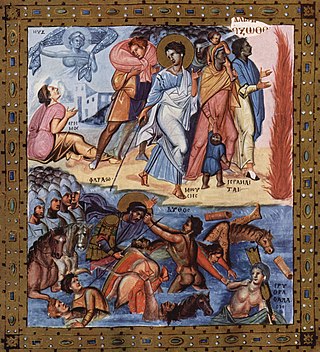Related Research Articles

The Ostromir Gospels is the oldest dated East Slavic book.. The Ostromir Gospels was created by deacon Gregory for his patron, Posadnik Ostromir of Novgorod, in 1056 or 1057, probably as a gift for a monastery.

The Stavelot Triptych is a medieval reliquary and portable altar in gold and enamel intended to protect, honor and display pieces of the True Cross. Created by Mosan artists—"Mosan" signifies the valley of the Meuse river—around 1156 at Stavelot Abbey in present-day Belgium. The work is a masterpiece of Romanesque goldsmith's work and is today in the Morgan Library & Museum in New York City.

The Madrid Skylitzes is a twelfth century illuminated manuscript version of the Synopsis of Histories, by John Skylitzes, which covers the reigns of the Byzantine emperors from the death of Nicephorus I in 811 to the deposition of Michael VI in 1057. The manuscript was produced in Norman Sicily and is now at the Biblioteca Nacional de España in Madrid, with the shelfmark MS Graecus Vitr. 26–2. Other names for it are Codex Græcus Matritensis Ioannis Skyllitzes and Skyllitzes Matritensis.
Chludov Psalter is an illuminated marginal Psalter made in the middle of the 9th Century. It is a unique monument of Byzantine art at the time of the Iconoclasm, one of only three illuminated Byzantine Psalters to survive from the 9th century.

Crusader art or the art of the Crusades, meaning primarily the art produced in Middle Eastern areas under Crusader control, spanned two artistic periods in Europe, the Romanesque and the Gothic, but in the Crusader kingdoms of the Levant the Gothic style barely appeared. The military crusaders themselves were mostly interested in artistic and development matters, or sophisticated in their taste, and much of their art was destroyed in the loss of their kingdoms so that only a few pieces survive today. Probably their most notable and influential artistic achievement was the Crusader castles, many of which achieve a stark, massive beauty. They developed the Byzantine methods of city-fortification for stand-alone castles far larger than any constructed before, either locally or in Europe.

Macedonian art is the art of the Macedonian Renaissance in Byzantine art. The period followed the end of the Byzantine iconoclasm and lasted until the fall of the Macedonian dynasty, which ruled the Byzantine Empire from 867 to 1056, having originated in the theme of Macedonia. It coincided with the Ottonian Renaissance in Western Europe. In the 9th and 10th centuries, the Byzantine Empire's military situation improved, and art and architecture revived.

The Harbaville Triptych is a Byzantine ivory triptych of the middle of the 10th century with a Deesis and other saints, now in the Louvre. Traces of colouring can still be seen on some figures. It is regarded as the finest, and best-preserved, of the "Romanos group" of ivories from a workshop in Constantinople, probably closely connected with the Imperial Court.

The Ladder of Divine Ascent or Ladder of Paradise is an important ascetical treatise for monasticism in Eastern Christianity, written by John Climacus in c. 600 AD; it was requested by John, Abbot of the Raithu monastery.
Jaroslav Thayer Folda III is a medievalist, in which field he is a Haskins Medal winner; he is a scholar in the history of the art of the Crusades and the N. Ferebee Taylor Professor of the History of Art at the University of North Carolina. His area of interest for teaching and research is the art of the Middle Ages in Europe and the Mediterranean world.

Byzantine studies is an interdisciplinary branch of the humanities that addresses the history, culture, demography, dress, religion/theology, art, literature/epigraphy, music, science, economy, coinage and politics of the Eastern Roman Empire. The discipline's founder in Germany is considered to be the philologist Hieronymus Wolf (1516–1580), a Renaissance Humanist. He gave the name "Byzantine" to the Eastern Roman Empire that continued after the Western Roman Empire collapsed in 476 AD. About 100 years after the final conquest of Constantinople by the Ottomans, Wolf began to collect, edit, and translate the writings of Byzantine philosophers. Other 16th-century humanists introduced Byzantine studies to Holland and Italy. The subject may also be called Byzantinology or Byzantology, although these terms are usually found in English translations of original non-English sources. A scholar of Byzantine studies is called a Byzantinist.

The Veroli Casket is a Middle Byzantine casket, probably made in Constantinople in the late 10th or early 11th century, and now in Room 8 of the Victoria and Albert Museum, London. It is thought to have been made for a person close to the Imperial Court of Constantinople, the capital of the Byzantine Empire, and may have been used to hold scent bottles or jewellery. It was later in the Cathedral Treasury at Veroli, south east of Rome, until 1861.
Leo the Mathematician, the Grammarian or the Philosopher was a Byzantine philosopher and logician associated with the Macedonian Renaissance and the end of the Second Byzantine Iconoclasm. His only preserved writings are some notes contained in manuscripts of Plato's dialogues. He has been called a "true Renaissance man" and "the cleverest man in Byzantium in the 9th century". He was archbishop of Thessalonica and later became the head of the Magnaura School of philosophy in Constantinople, where he taught Aristotelian logic.

The Ladder of Divine Ascent is a late-12th-century Christian icon at Saint Catherine's Monastery, Mount Sinai.

The Menologion of Basil II is an illuminated manuscript designed as a church calendar or Eastern Orthodox Church service book (menologion) that was compiled c. 1000 AD, for the Byzantine Emperor Basil II. It contains a synaxarion, a short collection of saints' lives, compiled at Constantinople for liturgical use, and around 430 miniature paintings by eight different artists. It was unusual for a menologion from that era to be so richly painted. It currently resides in the Vatican Library . A full facsimile was produced in 1907.
S. Peter Cowe is Narekatsi Professor of Armenian Studies at UCLA and has taught at the Hebrew University of Jerusalem, University of Chicago, and Columbia University. He is also a writer, researcher.

The Borradaile Triptych is an ivory Byzantine triptych carved in Constantinople between 900 and 1000 AD. It was bequeathed by Charles Borradaile to the British Museum, in London, in 1923, and is one of the "Romanos Group" of ivories that are closely connected with the Imperial Court, along with the Harbaville Triptych and Wernher Triptych.

The Wernher Triptych is an ivory Byzantine triptych carved in Constantinople between 900 and 1000 AD.
The Icon of the Annunciation in St. Catherine's Monastery in Sinai, Egypt is an unusual Byzantine icon attributed to the late twelfth century. The Annunciation icon is an example of the late Komnenian-era style and was likely produced in Constantinople. The icon, tempera on wood, is one of the largest icons on display at St. Catherine's Monastery, at 61 cm high and 42.2 cm wide. Very similar Annunciation icons exist to help establish the date of the Sinai icon. One at Kurbinovo in Yugoslavia, dated 1191, and the icon at Lagoudhere on Cyprus, dated 1192. The icon has distinctive elements that lead art historians, such as Evans and Wixom, to suggest the icon may have been produced at St. Catherine's Monastery itself rather than Constantinople. The Annunciation icon shares features found exclusively on other icons only at the Sinai monastery, such as the reflective circles scored in the surface of the gold and the grisaille medallion with the infant Christ on the Virgin Mary's breast.

The Bedia Chalice is a piece of the medieval Georgian goldsmithery, a liturgical vessel made of ducat gold and richly decorated. Dated to c. 999, the chalice was commissioned by King Bagrat III for the Bedia Monastery in Abkhazia. Only the bowl of the vessel is preserved and currently kept at the Georgian National Museum in Tbilisi.

The Kokkinobaphos Master is the conventional name by which modern historians call a master miniaturist active in Constantinople, the capital of the Byzantine Empire, during the 12th century.
References
- ↑ 2014 interview on the occasion of winning the Iran Book of the Year
- ↑ Armenia! on Metropolitan Museum of Art website
- ↑ Helen C. Evans was awarded by the Order of Friendship